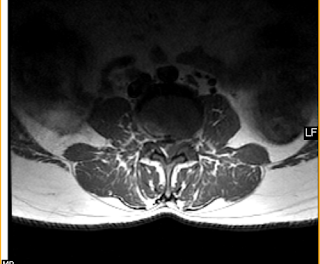Rare Posterior Epidural Disk Sequestration-MRI





This is a 40 year old male with sudden onset paraparesis. Posterior and left lateral epidural lesion in the L2-L3 showing hypointense signal on T1 weighted image and hyperintense signal on T2 weighted image along with peripheral rim enhancement on post gadolinium images. This may suggest an extruded disc with left lateral and cranial migration along with posterior epidural sequestration, which is although rare but reported. Other possibility is an infective posterior epidural collection.
Disk sequestration can be defined as a herniated disk with perforation of the fibrous ring (or outermost annulus fibrosus) and posterior longitudinal ligament with migration of the disk fragment to the epidural space. The most common path of disk fragment migration is a posterior and posterolateral direction to the anterior epidural space, which is delimited by the attachment of the posterior longitudinal ligament and its associated “midline septum” and “lateral membranes.” Therefore, disk fragment migration usually occurs cranial, caudal, or lateral but seldom posterior to the anterior epidural space. Migration of a sequestrated disk fragment in this manner has been reported only rarely.
Disk sequestration can be defined as a herniated disk with perforation of the fibrous ring (or outermost annulus fibrosus) and posterior longitudinal ligament with migration of the disk fragment to the epidural space. The most common path of disk fragment migration is a posterior and posterolateral direction to the anterior epidural space, which is delimited by the attachment of the posterior longitudinal ligament and its associated “midline septum” and “lateral membranes.” Therefore, disk fragment migration usually occurs cranial, caudal, or lateral but seldom posterior to the anterior epidural space. Migration of a sequestrated disk fragment in this manner has been reported only rarely.
Second opinion by - Teleradiology Providers
Rare Posterior Epidural Disk Sequestration-MRI
 Reviewed by Sumer Sethi
on
Tuesday, November 17, 2009
Rating:
Reviewed by Sumer Sethi
on
Tuesday, November 17, 2009
Rating:
 Reviewed by Sumer Sethi
on
Tuesday, November 17, 2009
Rating:
Reviewed by Sumer Sethi
on
Tuesday, November 17, 2009
Rating:







2 comments:
Global fashion house brings you the world’s finest collection of Indian Sarees. Our collection includes the wide range of the most beautiful, elegant and durable Indian Sarees.
Please visit:
www.globalsaridelivery.com
An FDA advisory panel said Optimark and Omniscan used in patients with kidney disease could lead to a painful and lethal condition known as Nephrogenic Systemic Fibrosis.
The panel believes a new warning is needed for these contrast dyes, but they've been harming patients for years with little or no attention.
Read this to see who's at risk and what can be done: http://mri-nsf.com/?gclid=CO7Z2NDUyZ4CFc5L5QodHzNzrA
Post a Comment